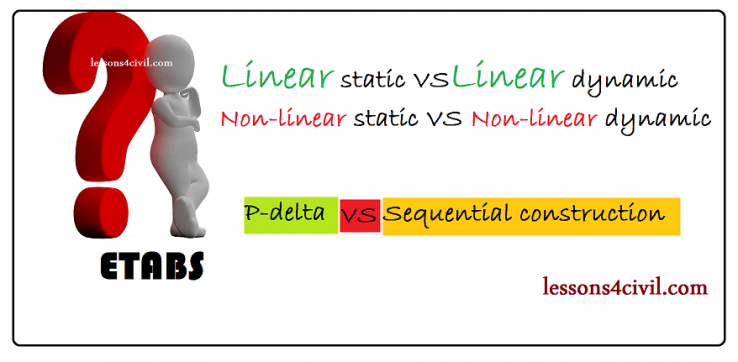Analysis Methods in ETABS
Analysis methods in ETABS is an interesting topic. ETABS covers 6 different analysis methods which are listed below. Each method has its own advantages and limitations. So in this article I am going to briefly introduce their differences and for comprehensive information about this topic you can watch a video lesson.
- Linear static analysis
- Linear dynamic analysis
- Spectrum analysis
- History analysis
- P-delta method
- Sequential construction method
- Non-linear static analysis
- Non-linear dynamic analysis
Linear static analysis
This method is based on 3 assumptions. First the materials (the structure) deform linearly. Second, it models the earthquake as a static load. And finally, there resultant force is assumed as a ,multiple of the weight of the building. The first question is when using this model is in reasonably accurate? The answer of this question depends on which code you use in your country. Since US code is one of the most frequently used standards, in ETABS video lesson I cover some criteria to find out if you can use this method or not.
Linear dynamic analysis
In this method, earthquake is assumed as a load induced by ground motion. To estimate the overall response of the structure to the earthquake, the program consider several independent vibrational modes and combine them to obtain the effect of the earthquake.
Sequential construction analysis
In this method, loads are applied in sequence. The program considers a nonlinear behavior for structural members.
P-delta analysis
P-delta effect happens when a vertical member which is supposed to be loaded axially, is subjected to a side-way deformation due to lateral loading. In such cases as the vertical load take distance from its primary point of application, it causes a bending moment. The second order effect is called P-delta effect. But the most important question is when Using a P-delta analysis is necessary? In the video coarse I remark US code criteria to decide about it.
Non-linear static analysis
This method is also known as Pushover analysis. Briefly, in this method the lateral loading of earthquake is considered as a static load that increases during several steps. Moreover the deformation of the members is assumed nonlinear.
Non-linear dynamic analysis
In simple words dynamic analysis means changing the input parameters during the analysis. In this method, the program automatically updates the stiffness matrix of the structural members as they deforms. So from one step to another the stiffness matrix is going to change. Besides the deformations are considered nonlinear.
all in all, without gaining insight into different analysis methods, designing an optimized structure seems impossible. this article is only the beginning of the story. As always our comprehensive video lessons comes with a variety of examples to explain them in details.



Comments